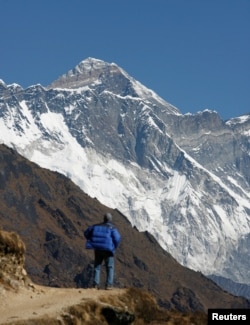Mount Everest, standing 8.85 kilometers above sea level, is Earth's tallest mountain.
And Mount Everest is still growing.
Mount Everest and the rest of the Himalayas are continuing on an upward movement that began at their birth around 50 million years ago. The mountains are a product of a collision between Eurasia and the Indian subcontinent.
But Everest is growing more than expected. And, scientists now think they know the reason why.
Everest's growth has to do with the major joining, or merger, of two nearby river systems. The Kosi river joined with the Arun river around 89,000 years ago, the researchers estimated.
This change in the area's river system has led to Everest gaining around 15-50 meters in height.
That suggests an upward movement rate of about 0.2-0.5 millimeters per year.
The geological process at work, researchers said, is called isostatic rebound.
Isostatic rebound involves the rise of land masses on Earth's crust when the weight of the surface declines. The crust, Earth's outermost part, floats atop hot, semi-liquid rock.
In this case, the joining of the rivers resulted in increased erosion which carried off large amounts of rock and soil. This reduced the weight of the area near Everest.
"Isostatic rebound can be likened to a floating object adjusting its position when weight is removed," said Jin-Gen Dai of China University of Geosciences in Beijing.
Dai is one of the leaders of the study published recently in Nature Geoscience.
"When a heavy load, such as ice or eroded rock, is removed from the Earth's crust, the land beneath slowly rises in response, much like a boat rising in water when cargo is unloaded," Dai added.
The researchers, who used numerical models to study the development of the river system, estimated that isostatic rebound accounts for about 10 percent of Everest's yearly upward movement, or uplift rate.
This geological process is seen in other places around the world.
"A classic example is in Scandinavia, where the land is still rising in response to the melting of thick ice sheets that covered the region during the last Ice Age. This process continues today, affecting coastlines and landscapes, thousands of years after the ice retreated," Dai said.
Study co-writer Adam Smith, a University College London doctoral student, said GPS measurements show the continued rising of Everest and the rest of the Himalayas.
This uplift is faster than the continued surface erosion caused by wind, rain and river flow. As this erosion continues, Everest's uplift rate from isostatic rebound may increase, Smith said.
Neighboring mountains, including Lhotse, the world's fourth highest, and Makalu, the fifth highest, also get a boost from the same process. Lhotse is experiencing an uplift rate similar to Everest. Makalu has a slightly higher uplift rate.
Dai said that the research shows our planet's changing nature. Even a seemingly unchanging element like Mount Everest is "subject to ongoing geological processes, reminding us that Earth is constantly changing, often in ways imperceptible in our daily lives."
Earth's rigid outer part is divided into large plates that move slowly over time. The Himalayas rose following a collision between two plates.
Everest is located on the border between Nepal and the Tibet Autonomous Region of China. It was named for George Everest, a 19th century British surveyor in India.
"Mount Everest occupies a unique place in human consciousness," Dai said.
"Physically, it represents Earth's highest point," giving it a lot of importance simply because of its size, Dai explained.
He added that Everest has cultural importance to local Sherpa and Tibetan communities. Worldwide, Dai said, the mountain represents a big test for human endurance.
I'm John Russell.
Will Dunham reported on this story for Reuters. John Russell adapted it for VOA Learning English.
_____________________________________________
Words in This Story
crust – n. the outer part of a planet, moon, or asteroid
erosion – n. the process of diminishment or destruction by degrees
response – n. something constituting a reply or reaction
region – n. a broad geographic area distinguished by similar features
imperceptible – adj. extremely slight, gradual, or subtle
surveyor – n. one who determines and delineate the form, extent, and position of a tract of land by taking measurements
unique – adj. being without like or equal











Forum